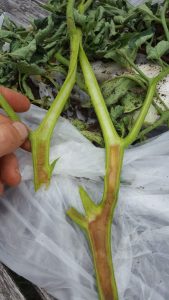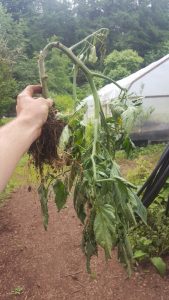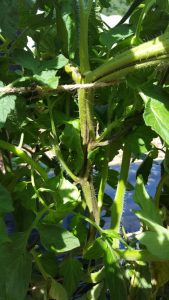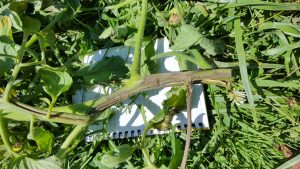Since I posted last week about the first fatalities in the field, I have watched as disease has spread through the field, targeting certain plants and avoiding many others. It has been a tumultuous week in my world and that of the tomatoes. The weather has heated up and begun to look more like our normal summers, with temperatures in the mid 80s and getting hotter, making for some nice growing conditions for the healthy plants. The plants with the compromised vascular systems have begun to suffer in the heat of the direct sunlight, unable to transport enough water to keep from drying out.
I am still waiting for the results of the pathology report from the dead tomato plants that I sent to WSU, I plan to dedicate this post to what diseases frequent a Pacific North West (PNW) tomato patch and my thoughts on what is afflicting my tomatoes in this 2019 trial.
A majority of the diseases that you will find in your PNW tomato plants will be fungal, and many of the fungal pathogens found in the Solanaceae family have similar symptoms with a few key distinguishing factors. A few common fungal pathogens are:
Verticillium Wilt (Verticillium albo-atrum): Yellowing or brown lesions on the leaves and/or the stem, often in a ‘V’ shape, are symptoms of the Verticillium. Verticillium often only affects one side of the plant, and because is can affect the stem, it will also affect the vascular system of the plant, causing it to wilt and often one will find a brown, rotted pith in the stem of the plant. (Verticillium, 2014)
Fusarium Wilt (Fusarium oxysporum sp.): Very similar to Verticillium, but rather than browning at the pith, the Fusarium Wilt attacks the outer edge of the pith in the vascular cambium. (Maryland, 2019)
Early Blight (Alternaria solani): The tell tale sign of this fungal pathogen is found in the yellowing, necrotic leaves. In the dead necrotic parts of the leaves (and sometimes the stems) are concentric circles that spread through the leaves. Early blight isn’t always detrimental and if the leaves are pruned and removed from the area, it shouldn’t effect your plant too heavily. (Ontario Crop IPM, 2009)
Late Blight (Phytophthora infestans): Irregular stem and leaf lesions that will spread through out the plant. When late blight sporulates, the brown/black lesions will be tinged with the white fruiting bodies that produce the spores. A sure sign of late blight is the brown necrotic lesions that are tinged with white. This fungal pathogen is a common end to most PNW tomato crops. (NC State, 2011)
Septoria Leaf Spot: Leaf and stem spots are all much smaller than with late blight and often have a characteristic tan center. Fruit are not affected, can be confused with flea beetle damage. (Cornell, 2019)
Field Observations:
Wilt: Between now and last Monday the 15th (where I observed 3 sick plants in the field), I have been observing as plants from 4 different varieties showed signs of a common disease. The varieties affected were the Pilu KS, Crimson Sprinter, Frederick, and Damsel. On the 16th my observations went from 3 effected plants to 8 plants showing varied severity of the disease that I have hypothesized to be Bacterial Wilt (Pseudomonas solanacearum). On the 18th and the 20th, I counted 11 sick plants that were the same on both dates. Now today (7/22), after a weekend of nice, warm weather, I counted only 6 plants showing signs of this common wilt. Of those 6 plants, only 4 looked to be quite unhealthy. Based off of my observations, this means that some of these plants were able to fight through whatever it was afflicting them. (Observations should be taken at mid day when the plants are at their worst) This does not mean that they are necessarily cured but that the plants are fighting through the disease. The two varieties that are being hit the hardest by this wilt are the Crimson Sprinter and the Pilu KS.
Something new: Aside from the plants that are wilting, I observed something new in the field today. It appears to be effecting the stems of 4 different plants. The disease looks like long, deep and black scars that move up the stem and into some branches. The stems that are afflicted the worst show no more green, living tissue and are completely hollow. While some branches have survived, I don’t expect any of the branches that are currently infected to survive much longer. A Galahad, two separated Red Racers, and a JTO 1007 are of the infected varieties. I am unsure of what this is and will be asking for assistance in diagnosing this disease as well. Here a few photos of the new disease:






Leave a Reply